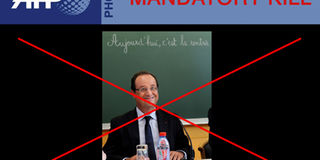AFP "kills" unflattering photo of French president

French news agency Agence France Presse withdrew a photo from it's wires saying they had “decided to kill the photo as we considered in retrospect that it provided nothing in news terms.” The decision raised concern that the agency was acting under orders from the French government, which it denied.
Original Caption on the photo: During a visit to the school Denain Michelet, September 3, 2013, Francois Hollande smiles, chairing a panel discussion on the reform of school timetables established by the government.
Notice from AFP asking that it is killed: Due to an editorial issue this picture has been withdrawn. Please remove it from all your systems. We are sorry for any inconvenience and thank you for your cooperation.
Philippe Massonnet, AFP’s global news director, later explained the decision:
The Internet has been abuzz, at least in France, ever since AFP transmitted this photo of French President Francois Hollande to clients on Tuesday, then quickly issued a “Mandatory Kill” order retracting it because it was deemed to be gratuitously unflattering to the president.
Immediately, AFP was accused of censorship and of having tried to suppress the photo on the direct order of the presidential office. This was not the case (otherwise we would not be republishing the image here).
Having said that, with the benefit of hindsight we see that the decision to retract the photo was clearly an error. Here’s what happened.
The photo in question was part of a series of about 30 images taken by Denis Charlet, a photographer from AFP’s bureau in Lille, during Hollande’s visit to a primary school in Denain in northern France. Tuesday was back-to-school day, known locally as “la rentrée” (hence the writing on the blackboard).
Most of the images from the series hardly lent themselves to controversy, depicting the president shaking hands as he arrived, or else looking over documents on a table set up in front of the blackboard.
And then there was this shot of the president, which soon ricocheted across the Internet.
A photo editor, noticing this image had been transmitted along with the other photos in the series, decided to issue an order to retract the picture. Why?
First of all, AFP has a rule not to transmit images that gratuitously ridicule people. The decision to publish each picture is based on its news or informational value. We never publish something purely for its shock value or to mock someone. Our photographers often catch public figures – at international conferences or waiting to give a speech, for instance – in unflattering but entirely human poses, such as with a finger in a nostril.
Another important point : The image was shot by a “pool” photographer, which means that he was taking photos not just for AFP but for our competitors as well, including Associated Press (AP), Reuters and the European Photo Agency (EPA). Such arrangements are common when physical space or access is limited, as in this classroom. Being a “pool” shooter carries a special responsibility – a photographer must capture the entirety of an event, avoid unusual angles, and make sure the photos cannot be misconstrued. So the decision to retract this photo was in line with our editorial guidelines.
It was also taken independent of any external pressure. The French presidency did not at any point ask us to take down the photo.
It is worth noting that the image below – which is similar but was deemed to be less unflattering – remains on our wires. It even became a “topshot”, one of the day’s highlighted pictures.
But the editorial decision to retract the photo – while it seemed sound at the time – created more problems than it solved. In trying to “kill” the photo after it had already been transmitted, we actually drew more attention to it and fueled the suspicion that AFP had bowed to political pressure, thus causing some people to call into question the agency’s credibility.
The order to kill the photo ironically breathed new life into this saga, and led to the image being massively shared across social networks in France, often accompanied by unkind comments about AFP.
The picture is quite banal and far from being scandalous in itself. AFP publishes an average of 2,500 photos daily, and this one would probably have gone largely unnoticed if we hadn’t asked our clients to retract it.
In 2003, Barbra Streisand unsuccessfully sought to suppress aerial photos of her Malibu home, shot by photographer Pictopia’s Kenneth Adelman to illustrate coastal erosion in California. She lost her lawsuit and the hitherto almost-unseen photos suddenly attracted worldwide notoriety, spawning the term “the Streisand effect.”
Our picture of Hollande is another good example of the phenomenon.



